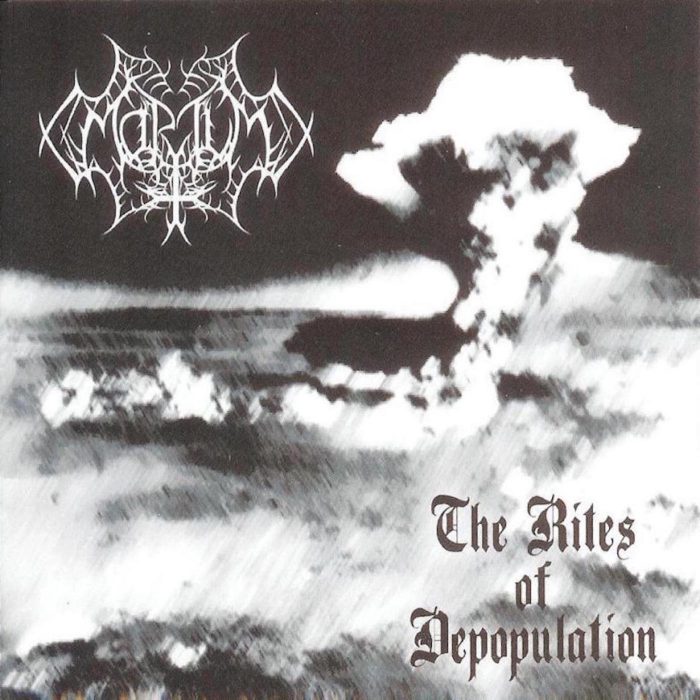
Mortum plays a streamlined style of black metal, applying it towards an almost shy efficiency and directed in the present album at expressing a series of simple musical ideas in different pieces through conservative yet noticeable development. While at first the adherence to conventional expressions of the genre might lead us to suspect an act based on nostalgia, what we find here is a black metal of stability and focus on one idea and its variations, rather than one of expressionist change and contrast. In accordance with this chosen precept, The Rites of Depopulation takes its time in allowing introductions to grow naturally, and follows them with expositions strong in a sense of continuation, to which the development adds thrust and power convincingly. But this is not a black metal of fireworks or gimmicks; rather, it is one of firm riffs grounded in traditional shapes, familiar, that Mortum succeeds in adapting and elaborating through their own ideas from a cultivated musical language decades in maturation.
In The Rites of Depopulation, riffs are oriented towards the building of phrases, and these phrases are considered and arranged to affect a grander flow, where each of individual section contributes its calculated fluxion [1]. A variety of approaches to riff construction is displayed which, taken out of context, might be suspected to have origins in other subgenres. More ‘classic’ heavy metal expressions crop up, though in measured quantities, which at times remind one of the way in which a band like Inquisition develops its blackened heavy metal. Some of most unhinged moments appearing in moments where it is sensed a gang [2] is required to break into a new space. Finally, and most suitably, we find here the preponderance of tremolo-picked death metal passages alternated mostly with power chord flutters and fast power chord blocks. These all tend to appear strongly subsumed under the aegis of Mortum’s personality, and even their discovery requires close and attentive listening.
On the subject of the development of musical ideas, the reason why a distanced or initial impression of the present music may be that of uniformity, is that transitions are crafted to give rise to a smooth and logical flow. Mortum, in The Rites of Depopulation, utilizes subtle modulations in tempo that arrest or push the music forward so that interest and expectation is created by either in context. Links between sections are not forged through explicit exact repetitions, but the basic need to at least sustain relationships with the use of motif-forms [3] is addressed. Modified repetitions, increasingly foreign depending on the intended effect and the circumstance, are used to progress logically but with more or less contrast. Mortum shows a snipe-like dominion in the consideration of the effects of musical areas, attending to a minutae of details concerning variations in tempo, rhythms, motif and percussion intensity.
If one must draw parallels with past eras, there is not one single trace of imitation. Upon close inspection of each pattern, and on how these patterns are used to construct whole pieces, we see Mortum taking the language of black metal and through it expressing their own ideas [4]. The way in which this expression takes place, hiding in between the lines, but patent upon close inspection, reveals a keen vision with a secretive disposition. This secretive disposition, coupled with the awarenes of flows over expanses of riff-built phrases, is what allows Mortum to rise above the morass, however unnoticed. But it is on the subject of the communication of a sense of finality, which arguably pieces of this kind should ideally accomplish, that we might yet see Mortum reach new levels of refinement and completeness.
Notes
[1] See the article Black Fluxions: https://www.deathmetal.org/article/black-fluxions/
[2] Refer to the discussion of Arnold Bernhard Marx theory of musical dynamics, where two general types of sections can be distinguished: the self-sufficient and assertive Satz on the one hand, and the motion-oriented, forward-moving Gang on the other.
[3] Refer to Arnold Schoenberg The Fundamentals of Musical Composition (1967, 1970), Chapters III (‘The Motive’) and IV (‘Connective Motive-Forms’).
[4] We saw this occuring with some of the better underground metal acts from Mexico back in the early nineties. The reader should refer to Transmetal Amanecer en el Mausoleo (1992), Cenotaph The Gloomy Reflection of Our Hidden Sorrows (1992), Xibalba Ah Dzam Poop Ek (1994) and Avzhia Dark Emperors (1996). An additional, notable and perhaps culturally related case is that of the Spanish black metal band Nazgul (later Uruk Hai).
Tags: 2011, Black Metal, mortum, the rites of depopulation


Some really good shit here. You should review their latest album as well.
The album cover on the jewel case edition of Eheieh Chaos does look tasty.
I’m still savoring The Rites of Depopulation, however.
I hear Burzum in this. However, it is not a Filosofem influence which is refreshing.